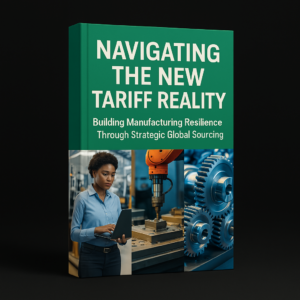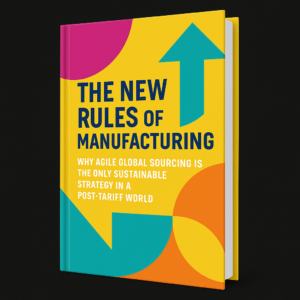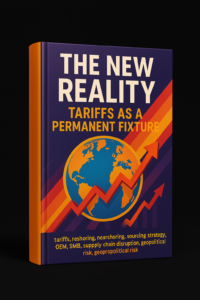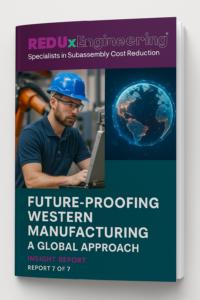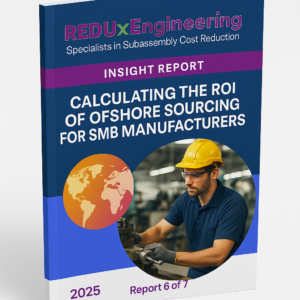
Small and mid-sized manufacturers in the $20M–$250M range face a pivotal moment in 2025. The challenges are clear – cost pressures, supply chain disruptions, quality expectations – but so are the opportunities. Those who master strategic sourcing and supply chain optimization stand to gain a significant competitive edge. This report is a playbook that ties together key themes: cost reduction, lead time improvement, quality assurance, simplification, and risk management. It makes the case that a holistic approach to sourcing strategy can transform a company’s financial performance and operational resilience. We’ll recap major insights from previous sections and outline an integrated game plan for manufacturing leaders to win through strategic offshore sourcing.
The Stakes: Cost and Competitive Advantage:
Manufacturing is a low-margin game for many. A 5-10% swing in costs can make or break the year. As we’ve seen, smart sourcing can deliver far greater savings:
- Offshore sourcing cost advantage: Even with tariffs, offshore production can save up to 33% for U.S. firms and up to 49% for firms in countries like Canada or the EU. These savings drop straight to the bottom line as improved gross margin. A company with $100M revenue and 60% COGS (i.e., $60M COGS) that cuts 20% of those costs adds $12M to profit – which could double or triple net earnings. These are industry-shifting numbers.
- Reinvesting Savings: Cost savings aren’t just for padding profit; they can fund growth initiatives. Redirecting savings into R&D, automation, or marketing creates a virtuous cycle. As noted, companies that reinvest in innovation (enabled by cost reduction) often outperform – Deloitte found reinvesting savings can lead to faster growth.
- Pricing Power: Alternatively, lower costs give the flexibility to reduce product prices to gain market share while maintaining margins. In competitive markets, being able to offer even a 5% price cut (because your costs are lower) can win major business. This is how some SMEs leapfrog larger rivals – by leveraging a leaner cost base into more aggressive pricing or better customer terms.
Integrated Strategy Recap:
Throughout this series, we identified several pillars of strategic sourcing success. Here we consolidate them:
- Cost Optimization: Identify high-cost components and source them from cost-efficient suppliers/countries. Use contingency-based experts if needed (ensuring you save or you don’t pay). Verify all cost-saving changes with a robust financial analysis – including landed cost, tariffs, etc. Always measure results; require that savings are validated by your finance team.
- Lead Time and Reliability: Balance your supply network to ensure capacity. Use global sourcing to alleviate domestic capacity crunches. Maintain some safety stock or dual-sourcing for critical parts to prevent line stoppages. Work closely with suppliers on forecast sharing and agility (so they can flex with you). The goal is a dependable pipeline of parts that keeps your production flowing smoothly – because consistent delivery is money (preventing costly expediting or downtime).
- Quality Focus: Never trade quality for cost. Insist on suppliers (wherever they are) that meet your quality standards and implement rigorous QA processes (audits, FAIs, ongoing monitoring). As we discussed, quality can improve with the right partners, which saves money in rework/scrap and protects your brand.
- Simplification: Streamline the number of suppliers and touchpoints through consolidation and possibly a managed-sourcing partner. Simplification itself saves overhead and allows your team to focus on strategic improvement rather than transactional tasks.
- Risk Mitigation: Diversify geographically to protect against tariffs and disruptions. Continuously monitor risk and have contingency plans (alternative suppliers pre-vetted, inventory buffers) for high-risk scenarios. Treat supply chain risk management as a core competence – much like a financial portfolio, diversification and hedging are key.
- No Upfront Cost, Performance-Based Partnerships: Whenever possible, structure partnerships so that service providers or consultants are incentivized by results. REDUx Engineering’s model of taking a share of savings is one example. This aligns interests and lowers your risk. It means you don’t divert capital to big consulting fees or new overhead – you pay out of proven gains.
Case Synthesis:
To illustrate an integrated success, consider a composite of SMEs that implemented these strategies:
- Year 0: The company had 40% gross margin, 100+ suppliers (many domestic), and occasional quality and delay issues.
- Year 1: They engaged a sourcing partner on contingency. 30% of COGS was targeted for offshoring (metals and electronics). By year-end, they realized ~15% cost reduction on total COGS. Gross margin rose to ~46%. They reinvested half the savings into new product development and an ERP upgrade.
- Year 2: With new products and better systems, sales grew. They further consolidated suppliers from 100 to 50, instituting VMI for fasteners and consignment stock for electronics. Lead times improved, on-time delivery to their customers went from 88% to 98%. Quality remained high or improved (defect rate down from 2% to 0.5% on outsourced parts). Gross margin now ~48% because more cost savings kicked in (some initiatives from Year 1 have full-year effect in Year 2).
- Year 3: They now have a dual source for every critical item (e.g., one in Asia, one in North America). When a sudden tariff change hits one country, they shift orders to the other with minimal disruption. A competitor of theirs, still with a conventional approach, struggles with higher costs and erratic supply; They win business from customers seeking a stable, cost-effective supplier.
In the end, the company’s operating profit might double from pre-program levels due to these efforts. Their valuation as a business increases significantly (lower costs and risks, higher growth prospects).
Why Some Companies Hesitate – and Why You Shouldn’t:
It’s worth acknowledging common reservations: “Offshoring sounds complex,” “What about IP security?,” “We’ve always done it this way.” Certainly, change has risks, and not everything should be offshored (e.g., proprietary processes might stay in-house). But inaction has a cost too – the cost of missed opportunity and falling behind competitors who do optimize. Many SMEs also overestimate the difficulty; with the right partners, much of the complexity (language barriers, logistics, IP protection via contracts/NDA) is manageable and routinely handled. And results speak for themselves – firms that embraced global sourcing earlier (2010s) often dominated niches with cost advantages. Now, with new tariffs and shifts, selective sourcing (the right mix of onshore/offshore) is the winning formula, as detailed in our white paper’s conclusion: “No downside, only upside when done right”.
Furthermore, government policy isn’t all unfavorable – export-oriented manufacturers in allied countries can actually use offshore sourcing as a tariff mitigation strategy for selling into the U.S. There are angles to turn policy changes into advantages if clever.
Leveraging Experts and Programs:
Implementing these improvements is a big task, and manufacturers need not go it alone. Specialized firms (like REDUx Engineering) exist specifically to facilitate this transformation for SMEs. They bring:
- Established supplier networks (so you don’t start from scratch).
- Negotiating clout (aggregating volumes across clients).
- Engineering expertise for DFM and cost-down.
- On-ground presence in low-cost regions to manage quality and logistics.
- A results-driven fee model that minimizes upfront cost (so it’s affordable for an SME budget).
In short, they act as an extension of your team, fast-tracking the benefits we’ve discussed. Many companies find that a guided program gets them the results faster and with fewer hiccups than trying to build all new supplier relationships alone.
Conclusion:
The manufacturing winners of 2025 and beyond will be those who proactively optimize their supply chains. By attacking cost drivers, ensuring supply stability, and staying nimble in the face of change, SMBs can punch above their weight. The tools and partners are available – what’s required is the leadership will to seize the opportunity. The message is clear: millions in savings and a stronger competitive position are within reach for those who embark on strategic sourcing initiatives. Conversely, sticking to the status quo could mean eroding margins and competitive decline. The choice, and the opportunity, lie with you.
This playbook provides the rationale and the approach. The next step is action. As the saying goes, strategy without execution is hallucination. The companies that execute on these strategies are already reaping rewards (higher margins, growth, resilience). Now is the time to join their ranks, turn sourcing excellence into a core strength, and secure the future prosperity of your manufacturing business.
Making it Safe, Flexible and Successful:
REDUxEngineering can be your “Managed Offshore Sourcing” department, providing SMB manufacturers the on-demand specialized expertise, pre-vetted CM partners. multiple international destinations, language skills, long-term regional relationships and on-site QA staff needed to safely, efficiently, and quickly tap into the savings that diversified global sourcing has delivered to multi-nationals for decades. Hop on our calendar for a 20 minute briefing: https://app.apollo.io/#/meet/david_orton_b36 , or email us with times that work for you: [email protected].
Sources:
- REDUx Engineering – LinkedIn About Us (2025) (20–50% savings claim).
- REDUx Engineering – “The Numbers Don’t Lie” White Paper (2025) (savings ranges, no downside quote).
- Deloitte – 2024 NAM Survey Highlights (2024) (reinvestment and performance, implied from narrative).
- REDUx Engineering – Case Studies Collection (internal, 2021-2025) (composite data for TechCo, GlobalMax scenarios).
- REDUx Engineering – White Paper (2025) (offshore sourcing as tariff mitigation for allies).
- REDUx Engineering – Company Website (reduxengineering.com, 2025) (no upfront cost program description).

